
Search
The Renewable Energy site for Do-It-Yourselfers
PEX Collector --
Performance
|
This section provides some
preliminary performance measurements and estimates for the PEX collector:
|
|
Prototype Collector Heating 35
Gallon Water Tank
I've recorded several days with the
prototype 4X8 ft collector hooked up to an 35 gallon insulated tank --see the
picture. This gives some idea how the real life performance might work out
for solar water or space heating.
Even though its April, the weather
has been part sunny with low ambient temperatures -- probably more typical of
winter in most places -- the joys of Montana Springs -- 5 inches of new snow
today!
On days with descent sun, the
prototype has managed to heat up the 35 gallons to a useable hot water
temperature on part cloudy days. See plots below.
The prototype would do even better
with: 1) no gaps between the aluminum fins -- I think this might be good for an
about 7% improvement, and 2) a water storage tank that was inside or better
insulated.
At any rate, the current prototype
performance seems about right for 2 peoples typical hot water needs. I
think this is pretty close to what one would expect from a similar size
commercial unit.
Test Setup:
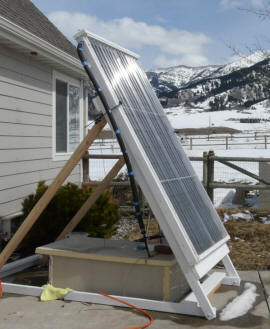
Prototype with 35 gallon tank in
insulated box below. |
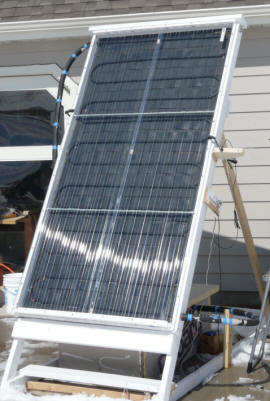
Prototype from other side.
Small black gadget attached to right
side measures sun intensity. |
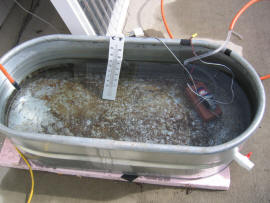
This is the 35 gallon tank before insulating. The 12 volt
submersible March pump can be seen at the right.
All the scum on the bottom comes from a previous use.
Click on pictures to enlarge |
Pictures show the test setup for the
prototype.
The instrumentation consisted of a
temperature logger to measure 1) collect water inlet temperature, 2) collector
water outlet temperature, 3) collector air temperature at the top, 4) ambient
air temperature, and 5) solar intensity using an Apogee pyranometer. The
flow rate was measured by recording the time to fill a half gallon container.
Performance Plots:
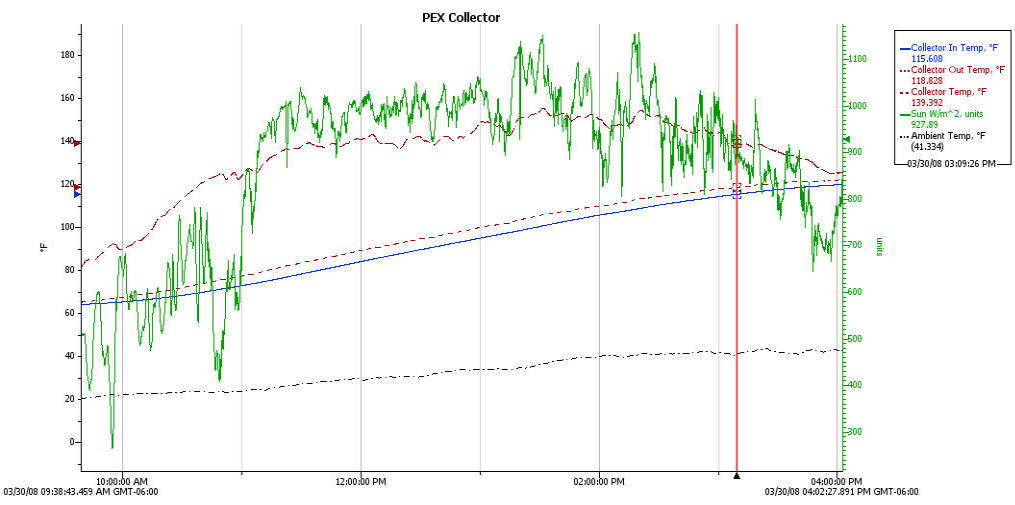
This is a good sun day with only some
clouds in the morning.
On the plot:
Blue solid line is the collector
inlet temperature (that is, the pump outlet temperature)
Red short dash line is the collector outlet temperature
Red long das line is the
temperature of the collector air near the top.
Black dash-dot line is the ambient temperature
Green line is the solar intensity in w/m^2
The flow rate for this test was
XX gpm.
So, the collector raised
the tank water temperature (35 gallons) from about 65F to 116F on this mostly
sunny, but cold day. Ambient temperatures started at 20F and got only up
to about 40F by afternoon.
As noted above, performance
would have been even better with a well insulated or indoor tank and with more
care in not leaving gaps between the fins in the collector.
Another Day Plot:
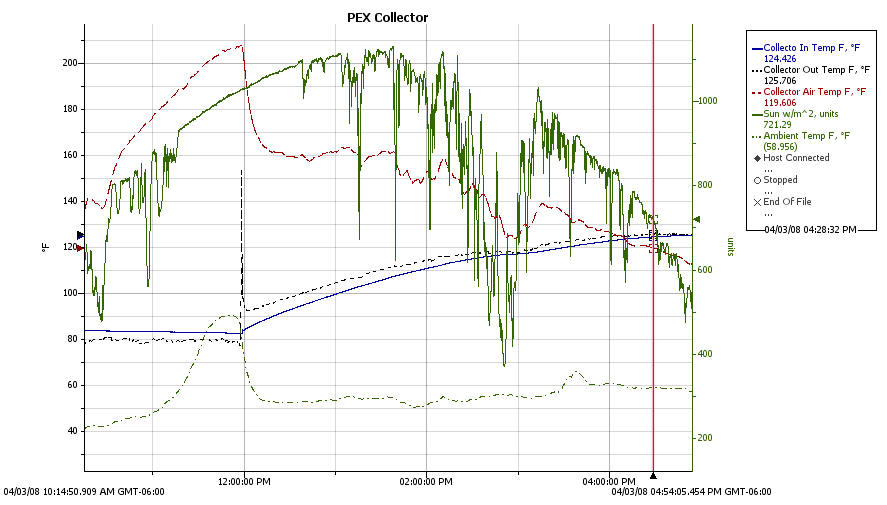
April 3, 2008 performance.
This was a part sunny day
with some clouds in the afternoon.
I was late to turn the pump
on, so there is no collection until about 12:00 on the plot.
The tank started at about
80F, and reached about 125F by the end of the collection period.
It is interesting to note
what happens to the collector air temperature in the morning.
Without water flow to cool
the collector, it climbs steadily up to nearly 210F at 12:00. At this
point, the pump is turned on, and the air temperature drops quickly to about
160F. So, even with the cool ambient temperatures (50F), the need to
consider high stagnation temperatures is apparent.
Note that the peak in
ambient temperature in the morning just before noon is bad data -- the ambient
temperature sensor was in the sun during this half hour or so. Its OK
before 11:00 and OK after 12:15.
PEX to Aluminum Fin Tests
I'm
just getting started on some testing to try to optimize the fin to PEX heat
transfer. The little test board shown below allows the thermal
performance of two or three fin to PEX connection arrangements to be directly
compared to each other. Each different arrangement consists of about 4 ft
of PEX and fin in a U shaped arrangement. Water from a bucket is pumped
through the 4 ft using a small submersible pump in each bucket. The higher
the rate of temperature rise in the bucket, the more efficient the fin to PEX
arrangement is.
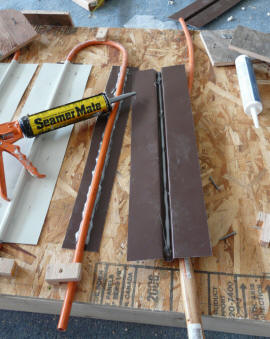
PEX and fins being installed on the
test board. |
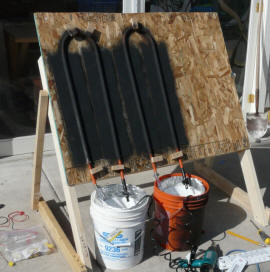
This arrangement tests two different
fin/PEX couping arrangements.
Each of the two U shaped tubes
is supplied by a separate bucket and
pump. The one that heats its bucket
of water fastest is better. |
I'm planning to test at
least the following:
- Different materials
between the aluminum fin and the PEX pipe (silicone, filled silicone, ...)
- Different fin
arrangements (the prototype arrangement, two fins with PEX sandwiched
between, ...)
- A copper pipe with
aluminum fin with silicone between (just to verify the effect of the thermal
resistance of the PEX tube wall)
Its going to be a couple
weeks before I can get back to this.
I am not expecting anything revolutionary out of this. I think the test is
likely to confirm that the major resistance to heat transfer from the fin to the
water inside the PEX tube is the wall of the PEX tube itself. But, I
think some modest improvements might be possible, and, if not, the performance
of the current prototype arrangement seems good enough.
It seems to me that the
things that are likely to make the performance improve are:
-
Maximum contact area
between the aluminum fin and the PEX -- wrapping it 360 degrees would be
ideal.
-
Tight fit between the
aluminum and the PEX -- a paper thin gap
-
A good filler between
the aluminum and the PEX to eliminate any poorly conducting air film
-
Using PEX-AL-PEX
instead of PEX because it has better thermal conductivity.
-
Narrower fins because
the narrower the fin, 1) the more efficient the fin is, and 2) the less heat
has to be transferred into a unit length of PEX
-
Larger diameter PEX, as
this increases the heat transfer surface area.
-
What else?
Calculated Performance Compared to Copper
Absorber
The calculation below
attempts to estimate how much hotter the aluminum fin must run compared to an
all copper collector in order to transfer the same amount of heat into the
water. The slope of a typical collector efficiency curve is then
used to estimate how much of an efficiency decrease the PEX results in compared
to an all copper absorber.
< show the calculated temperature
drop across the PEX wall>
<what would 5/8 PEX do?
Gary April 5, 2008







